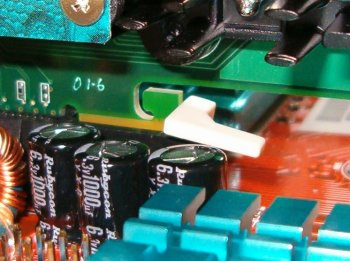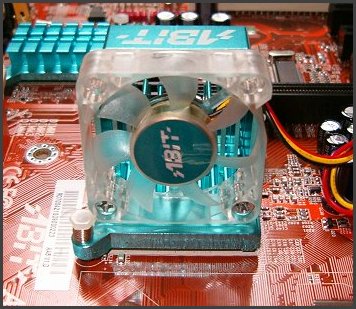Layout
Starting at the top left and reading the mainboard as you would an English language text, we hit the CPU's ATX12V auxiliary power source, surrounded by the 4-phase CPU power delivery system. That set of componentry flanks the CPU socket area on the north and west sides, as you look at the motherboard. Given that Intel rigidly defines the socket area, it's no surprise to see that area free of any obstruction, for mounting Intel's latest cooler design or any future aftermarket product.
The DDR-II slot quartet is next, followed by an EPS 24-pin power connector. The board is able to run using a regular ATX power supply, the connector fitting into the rightmost twenty pins of the connector, leaving four spare on the left. Those four unused pins, should you choose not to use an EPS power supply, supply auxiliary power to the CPU, to add to the supply given by ATX12V in the corner.
The northbridge cooler sits above the PEG16X slot. An innovative design, the cooler draws air over the heatsink's fins. The fan isn't especially loud, although it does add some audible noise to the motherboard's aural profile.

One rather more worrying thing is the graphics card retention mechanism used on the AA8. Intel's D925XCV used a new card retention mechanism that slots over a GeForce 6800-series's end tab perfectly, whereas the AA8 uses an older style of mechanism that's incompatible with end tab used on those boards. The picture above shows you what I mean.
ATI's PCI Express X600 XT has a different end tab that the AA8 is compatible with. I'm guessing NVIDIA will modify any shipping 6800 boards to revert to the old end tab style, since it's compatible with Intel's new motherboards too.
The Realtek 8110S sits to the left of the PEG16X slot in the usual Ethernet PHY position. The AA8's use of three PCI Express 1X peripheral expansion slots has allowed ABIT to bring the southbridge, passively cooled by that natty blue heatsink, in closer to the PEG16X graphics slot.
Underneath the battery sits a group of four SATA ports, each of them tied to the SATA150 AHCI channels that the Matrix Storage controller on the ICH6/R provides. To the right of those, directly on the board edge, you'll find the sole IDE port, rotated so that its pins face out from the board's edge.
With the pair of PCI slots in standard places (where else are they going to go?), the last thing to talk about is the floppy connector position, underneath those PCI slots on the bottom edge of the board. While using a floppy drive is an abhorrent thing to do in most cases, installing Window XP onto a RAID volume setup using the Matrix Storage controller will require one, so the port placement comes into question. It's not optimal, requiring you to probably drag your floppy cable over the SATA port area.
It's the only real layout faux pas though, along with the graphics card retention mechanism, in a board that implements a very sane layout, most of which is dictated by the CPU heatsink area and the PCI and PCI Express slots used.
As for the aesthetic, it's not to my taste. Get raving drunk and squint at it a bit and it looks like a grilled salmon with a few green beans thrown on, with a couple of black bits where you burnt it. You might like it though.












